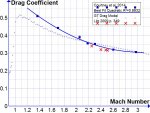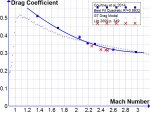For example, in the attached figure, we actually measured the Cds over a range from M1.36 to M2.98. The uncertainty in Cd at each Mach number is about 1%, but at one point is closer to 2% and shown with error bars.
This is a good example, let's consider it for a moment.
So you measured the drag of a bullet at Mach 1.36 (~1517 fps), probably over 100 or 200 yards.
My question is; what barrel twist did you use to test the bullet at this speed?
As a bullet slows down on a long range trajectory, its spin rate doesn't decay as fast as it's forward velocity, which means that if it was turning 1:9" @3100 fps from the muzzle, by the time it's lost 1/2 it's velocity, it will be spinning at a rate much faster than 1:9", probably closer to 1:6".
So my question to you is, did you fire your low velocity data points from a faster twist barrel than your high velocity data points? If not, then the data point is not representative of the bullets actual stability condition at that speed on a real long range shot.
Another question; didn't you publish on the effects of tip off rate affecting BC? If you fire the bullet at 1517 fps MV and you gather that data point where there's a 'tip-off' rate which reduces BC, then, again, it won't be flying as it really does on a long range shot.
And now to answer your question.
The reason my data points appear to be clustered tightly together is because they represent the center of the speed range tested. Since I test over long range, a shot with a MV of 3200 fps which slows to 1600 fps, will have a midpoint of ~M2.15. So that's where the data point would sit. My data points appear clustered on the graph, but my measurements are a more accurate representation of the bullets actual drag at long range.
This is another example of you dwelling on the minutia in order to twist the facts. Yes it's a fact that you tested a data point at M1.36. It's also a fact that that data point doesn't represent the bullets actual drag at that speed on a real long range shot.
I'm going to go out on a limb here and say that actual shooters actually care about drag models which actually put them on target at long range more so than they care about where your points are on a graph and why you say your way is better.
A scientific/engineering discussion should focus on the facts rather than the personalities.
You'd like that wouldn't you. Except you loose the scientific/engineering points as well because your 'facts' are not in alignment with what shooters experience (or they're abstract and irrelevant). I still can't decide if you're twisting of all these facts is deliberate, or if you really just don't get it. It's been suggested that you just have an overwhelming appetite for attention, good or bad doesn't matter. If that's the case, you can make your therapy check out to Snipers Hide as a contribution for helping you with your mental issues.
One thing I am sure of is that shooters appreciate information that helps them hit targets. I don't ever recall you EVER providing any such information. What I do see a lot of from you is criticism of those who do.
As always, you keep doing what you do, and I'll keep doing what I do.
-Bryan





